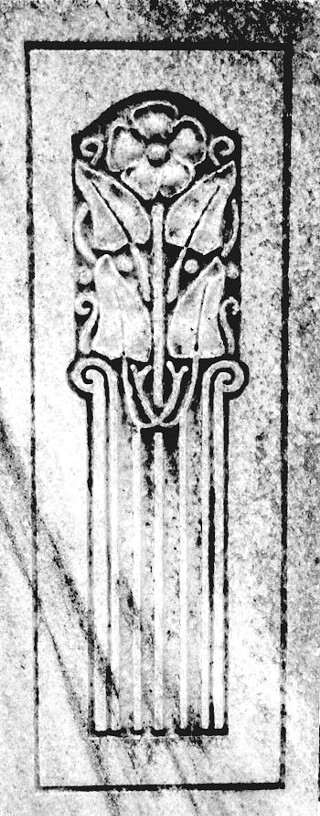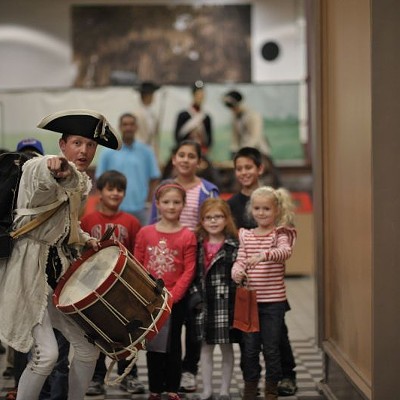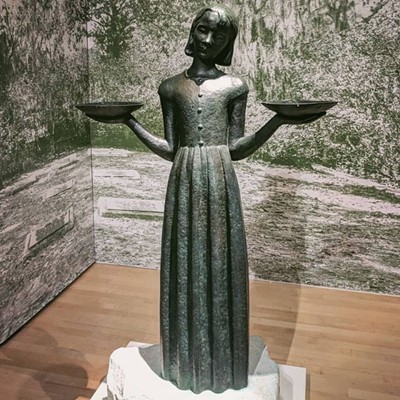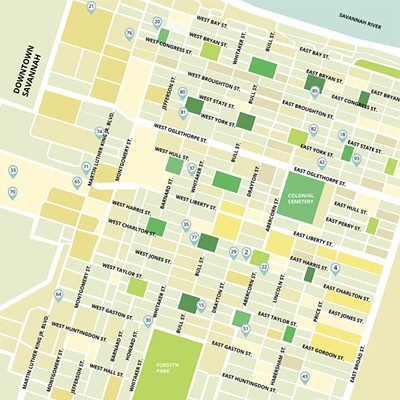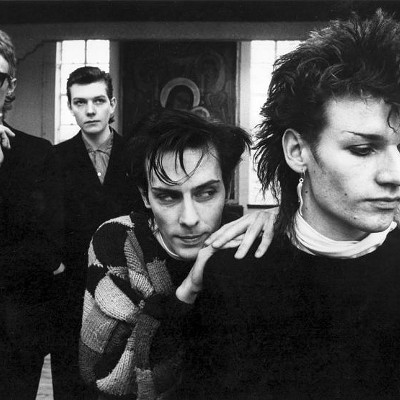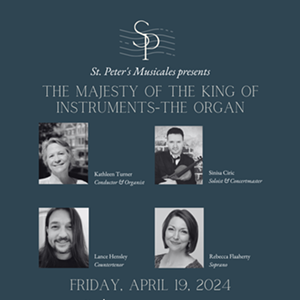Not every city would dedicate an entire day to celebrate a cemetery. But then again, Savannah’s not every city.
This Sunday, a remarkable and unique event will take place in Bonaventure Cemetery, as the city, the Bonaventure Historical Society and other groups join forces to offer a Bonaventure Centennial Celebration marking the cemetery's hundredth year of public ownership.
There will be refreshments, information booths, history lectures -- and of course the beautiful, poignant vistas of Bonaventure itself.
"There will be an incredible amount of activity," says event organizer Beth Delnostro, who stresses the educational nature of the event.
"We're not going to have a bunch of blowup things waving around," she says. "Nothing will be sold -- the refreshments are free. We're making this about education. "
From noon until 4, historical elements of Bonaventure Cemetery will be showcased, as well as modern-day exhibits from over two dozen organizations involved with the history and operation of the cemetery.
At 2 p.m. a more formal program takes place, with presentation of the colors by the American Legion, a short speech by Mayor Otis Johnson and a talk by local historican Hugh Golson.
Though burials took place there as far back as the 1700s, Bonaventure didn't become a true community cemetery until 1907, when the city acquired the acreage from a private firm which had run the site for much of the previous century.
"It wasn't until then that it became a public cemetery, but Bonaventure has always been a landmark site that has fascinated people," says Jerry Flemming, the city of Savannah's director of cemeteries.
"When it became a public cemetery that's when it opened up to the Greek community, the Jewish community, and a number of other groups."
Interestingly, Savannah's Greek community is also celebrating a centennial this year, marking the establishment of St. Paul's Greek Orthodox church here.
By the time of the city's purchase of Bonaventure in 1907 and the establishment that same year of St. Paul's in its original site at Duffy and Barnard, over 100 Greek immigrants lived in the Savannah area. (The congregation purchased the Lawton Memorial Building at Bull and Anderson in 1941, where it's based to this day.)
While most early burials were in Laurel Grove, in 1918 the community decided to buy eight lots in Section K of Bonaventure, and that section grew to be largely occupied by Greek burials and a few others of Eastern Orthodox background.
"What's unique about this Greek section K in Bonaventure is that many of the tombstones were carved with Greek lettering," says Helen McCracken, a St. Paul's parishioner who'll be staffing an information booth this Sunday about the Greek presence in the city and in Bonaventure.
"The Greek lettering on the monuments indicates the name, place and date of birth of the deceased," she says. "Sometimes they also include a short sentiment."
McCracken explains that while the Greek presence in Savannah goes back to the mid-1800s, the main wave of Greek immigration was from 1907-1920.
"Most of the early immigrants were single men, since it wasn't acceptable for women to travel on long and difficult trips," McCracken says. "Most of those early immigrants didn't plan to stay away from their homeland forever."
Instead, their hope was to make enough money to provide financial help for their families back in Greece, and especially to provide dowries for unmarried sisters.
"A Greek man couldn't marry unless his sisters were first married," says McCracken.
Indeed, while Bonaventure is known for its beauty, what keeps people coming back again and again are those individual names carved on those individual stones.
Some lived to very old ages after a lifetime of accomplishment. Some were buried as children in tiny plots, victims of disease, drowning or misfortune. But all had stories to tell.
When you stroll through that Greek Section K -- or the nearby Jewish cemetery with its Holocaust survivors, or the humble Spanish-American veterans burial site, or the old tombs near the bluff of the Wilmington River hosting the remains of some of Georgia's leading historical figures -- you realize that for those interred at Bonaventure, death ironically serves to highlight their life stories all the more.
Many names both obscure and notable have been inscribed on Bonaventure's tombstones, including Johnny Mercer, Conrad Aiken, Georgia's first governor Edward Telfair and his daughter Mary.
But as Flemming says, "From somebody's point of view everybody is notable, so I try not to get into all that."
With the tourist boom in the '90s following the publication of Midnight in the Garden of Good and Evil -- which featured the late Jack Leigh's iconic photograph of a Bonaventure gravesite on the cover -- the cemetery became the hot property it is today.
And that's where the Bonaventure Historical Society comes in.
"They've been in existence since 1994 and we've worked with them ever since," Flemming says. "A great thing they do is operate the visitor center when we're out of the office, especially on weekends."
Currently chairperson of the organization, Mildred Hill says that while the Bonaventure Historical Society was already established before "The Book" came out, "what 'The Book' did was prompt the Society to open the visitors center on Saturday and Sunday."
Flemming says that city staff is sometimes so overwhelmed with tourists asking for information that it can be difficult to serve the cemetery customers.
"With the Society operating the visitor center, they can handle all the information requests, and that allows our limited weekend staff to deal with our customers," Flemming says.
"In all honesty, I wouldn't mind seeing the Society volunteers seven days a week. There's really never a slow period in Bonaventure as far as tourism goes."
Hill says the Society is cooperating in that goal. "We want to try to have that visitors center open every day, because it's just amazing the number of people that come in that cemetery on a daily basis."
Flemming says while both private and public cemeteries are important, a large and historic site like Bonaventure is best managed as a public asset.
"A 100-acre site like this couldn't afford to be run as a private site. In the public arena I guess we'd call it public open green space. It's expensive to maintain. It's a million-dollar view out here. We've got live oak trees that are 250 years old," he says.
"If you have a public treasure like we do in Savannah with Bonaventure, you have an obligation to take care of it," he says. "That applies to cemeteries as well. Fortunately the Savannah community, who pays taxes to support cemetery conservation, has that understanding."
Mildred Hill of the Bonaventure Historical Society points out that "Not too many cities have a Department of Cemeteries. Some cities might maintain a historical cemetery, but they don't really have a whole department. That's one place I don't mind seeing tax dollars go. And the city does real restoration work -- they're not just interested in every square inch being a cemetery lot."
While its municipal status is relatively young, Flemming says that theoretically "you could say the cemetery was first developed in 1794 when Governor Tattnall buried a relative here."
Bonaventure's abundant beauty and once-remote location made it a natural choice as a cemetery, and Flemming says talk of making it public goes back much further than the actual 1907 sale to the city.
"You see that as early as 1842, when Henry Jackson was talking about the fitness of Bonaventure as a 'garden of the dead,' and there was talk about making it a public cemetery," he says.
Perhaps the first concrete mention comes in 1846, when a parcel of land, the northeast 78 acres of the current site, were deemed "suitable for a public cemetery." In 1847 the Evergreen firm was incorporated as owner of those acres, and they intended to eventually sell the land to the city, Flemming says.
The mid-1800s marked a flurry of activity in local cemeteries. "In 1849, Colonial Cemetery was in such bad condition that the Board of Health was urged to develop a new cemetery," Flemming explains.
So in 1850, Laurel Grove Cemetery opened, with Catholic Cemetery right behind it in 1853.
"So you had three cemeteries competing against each other -- if you can call it competetion," says Flemming. "Because of that the city didn't have an immediate need for a public cemetery."
At the time of its purchase by the city, Bonaventure was in the boonies.
"Prior to the city purchasing Bonaventure in 1907 the area was very rural, very forested," Flemming says. "Beyond the roadway was wilderness."
Much of the present look of Bonaventure was due to P.D. Daffin, head of the city's Park and Tree Department from 1898-1929 and for whom Daffin Park is named.
"While P.D. Daffin was in charge, that's when you find some of the clearing taking place, the planting of the azaleas and camellias and the stabilization of the bluff," Flemming says. "All that was done primarily between 1907 and 1923."
A second phase of landscaping began in the '70s.
"Tree planting within the past 30 years has opened up the space significantly," Flemming says. "Before then our cemeteries had somewhat of a jungle appearance to them. And of course there was a lot of criminal activity there."
Flemming says in the '70s an effort to "clean things up" at Bonaventure began.
"The conservation movement here started in the 1950s, and ever since we went to a city manager form of government some conservation effort has been in place," Flemming says. "Then the city adopted a cemetery conservation program in 1982 and is now doing first-class conservation."
Contrary to what you might think given the cemetery's high profile, the city has a hands-off policy on private burial sites at Bonaventure. "Even though it's a public cemetery, stones on private lots are the responsibility of the private lot owner," Flemming says.
However, public monuments -- such as those built with funds raised by nonprofits -- are managed by city staff.
"We also have abandoned lots we take care of," Flemming explains. "If there's no family in existence or no burial on the lot in over 70 years, we adopt it."
But Flemming says if a private owner wants to better conserve their monument, "we'll give consulting and advice."
Currently, three city employees primarily do cemetery conservation.
"It's highly technical work," Flemming says. "The state of the art in conservation these days is doing things the way they did it 200 years ago. That's sort of how conservation has evolved -- to do it in the original way.
"If time stood still it would still take us 100 years to do what needs to be done on just the public and abandoned sites. In the course of nature, things are always falling apart," he says.
Mildred Hill says despite being a resting place for the dead, Bonaventure has been and always will be a vital part of life in Savannah.
"I grew up in Thunderbolt, and as a kid we used to ride our bikes through Bonaventure all the time," Hill recalls. "The family would take a ride every Sunday afternoon, which always encompassed the cemetery. Bonaventure has been a part of my life always."
Hill says many members of both sides of her family are buried at Bonaventure. Thinking ahead, she's made plans for future residents, too.
"I want it so that in the years to come, our family members can visit four generations of us all in one stop," she laughs.
The Bonaventure Centennial Celebration is Sunday July 15, from noon -4 at the Cemetery. A commemorative program begins at 2 p.m. in Section F. Mayor Otis Johnson will address the group and historian Hugh Golson will be keynote speaker. Participating organizations include Fox and Weeks Funeral Directors, St. Paul's Greek Orthodox Church, Oglethorpe Marble and Granite, Thunderbolt Museum, Coastal Heritage Society, Congregation Mickve Israel, DePue Monument Co., Savannah Ogeechee Canal Society, and local Boy Scout troops. There will be music, tours, and activities for children.
To comment e-mail us at[email protected]
Did you know?
• Bonaventure Cemetery hosts about 500 burials a year. It's open every day of the year from 8 a.m. to 5 p.m.
• Cemeteries are classified as "active" or "inactive." Of Savannah's historic cemeteries, only Colonial Cemetery on Oglethorpe Avenue is inactive. Both Laurel Grove North and South are technically active, though they host far fewer burials than Bonaventure.
• Greenwich Cemetery, adjacent to Bonaventure, is also owned by the city and was developed in 1933. "They originally called it the 'Greenwich Addition to Bonaventure' to sort of play into the Bonaventure name, but we manage them as separate cemeteries," says City Cemetery Director Jerry Flemming.
• Forest Lawn, tucked between Bonaventure and Greenwich, is a private cemetery, owned by the same firm which runs Hillcrest Abbey.
• Catholic Cemetery on Wheaton Street is operated by the Catholic Diocese of Savannah.

